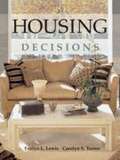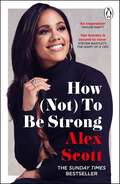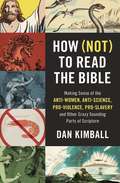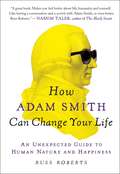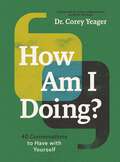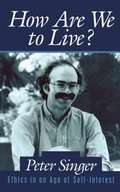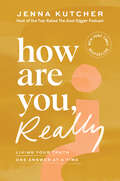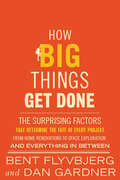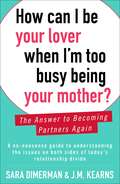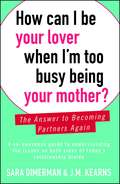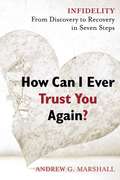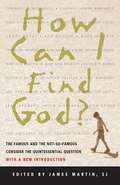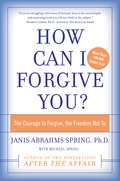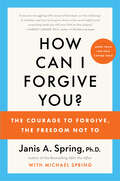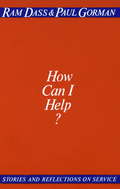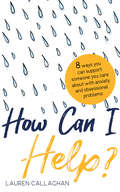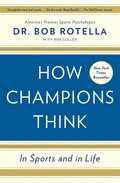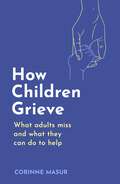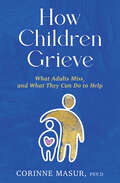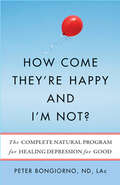- Table View
- List View
Housing Decisions
by Evelyn L. Lewis Carolyn S. TurnerGives students the guidelines they will need to make wise housing choices.
How (Not) To Be Strong: The inspirational instant Sunday Times Bestseller from the legendary Lioness
by Alex ScottAn inspiring memoir of finding strength and resilience from the former England Lioness.From the football cages of East London to broadcasting to millions, the engine powering Alex Scott's remarkable journey has always been her resilience. But thanks to a 'push-through mentality' the world has only ever seen the 'strong' side of Alex. Now, she is ready to lower the shield.In her candid memoir How (Not) to Be Strong, Alex shares the lessons that have shaped her, from finally confronting the legacy of a tumultuous childhood to tarnished truth behind the gleaming football trophies.With raw honesty, Alex shows how she's tackled life's challenges and that sometimes the strongest thing you can do is show your most vulnerable side to the world.
How (Not) to Read the Bible: Making Sense of the Anti-women, Anti-science, Pro-violence, Pro-slavery and Other Crazy-Sounding Parts of Scripture
by Dan KimballIs Reading the Bible the Fastest Way to Lode Your Faith?For centuries, the Bible was called "the Good Book," a moral and religious text that guides us into a relationship with God and shows us the right way to live. Today, however, some people argue the Bible is outdated and harmful, with many Christians unaware of some of the odd and disturbing things the Bible says.Whether you are a Christian, a doubter, or someone exploring the Bible for the first time, bestselling author Dan Kimball guides you step-by-step in how to make sense of these difficult and disturbing Bible passages. Filled with stories, visual illustrations, and memes reflecting popular cultural objections, How (Not) to Read the Bible is a lifeline for individuals who are confused or discouraged with questions about the Bible. It also works great as a small-group study or sermon series.X
How A Shy Guy Like Me Earned Over $1 Million in Network Marketing
by Joe BrownExplains the system the author developed that earned him a big incum in network marketing.
How Adam Smith Can Change Your Life: An Unexpected Guide to Human Nature and Happiness
by Russ RobertsA forgotten book by one of history's greatest thinkers reveals the surprising connections between happiness, virtue, fame, and fortune.Adam Smith may have become the patron saint of capitalism after he penned his most famous work, The Wealth of Nations. But few people know that when it came to the behavior of individuals--the way we perceive ourselves, the way we treat others, and the decisions we make in pursuit of happiness--the Scottish philosopher had just as much to say. He developed his ideas on human nature in an epic, sprawling work titled The Theory of Moral Sentiments.Most economists have never read it, and for most of his life, Russ Roberts was no exception. But when he finally picked up the book by the founder of his field, he realized he'd stumbled upon what might be the greatest self-help book that almost no one has read.In How Adam Smith Can Change Your Life, Roberts examines Smith's forgotten masterpiece, and finds a treasure trove of timeless, practical wisdom. Smith's insights into human nature are just as relevant today as they were three hundred years ago. What does it take to be truly happy? Should we pursue fame and fortune or the respect of our friends and family? How can we make the world a better place? Smith's unexpected answers, framed within the rich context of current events, literature, history, and pop culture, are at once profound, counterintuitive, and highly entertaining.By reinvigorating Smith's neglected classic, Roberts provides us with an invaluable look at human behavior through the lens of one of history's greatest minds.
How Am I Doing?: 40 Conversations to Have with Yourself
by Dr. Corey YeagerLife is hard. But it gets a whole lot easier when you start to talk it out. In How Am I Doing?, you're invited into a series of conversations with yourself to discover your purpose, honor your story, and explore who you want to be.Dr. Corey Yeager, psychotherapist for the NBA&’s Detroit Pistons and most recently featured on Oprah and Prince Harry's The Me You Can't See on Apple TV+, offers you 40 questions to help you raise awareness of your thoughts and emotions and reconnect with who you want to be.Over the course of these 40 conversations with yourself, you're invited to:Build trust with yourselfConsider how past traumas affect your life todayGrow a practice of positive self-talkLet go of guilt and regret from your pastDevelop mental health strategies for what to for moments when you're depressed or anxiousIncrease your confidence and embrace your emotions Each of the 40 questions is paired with a short, thoughtful reflection from Dr. Yeager, along with prompts and self-care strategies to help you look at yourself in the mirror and come into alignment with who you want to be.So join the conversation; nothing is off-limits here. Come check in with yourself and take these small, simple steps to journey toward a more honest and harmonious way of living.
How Are We to Live?: Ethics in an Age of Self-Interest
by Peter Singerrefutes the idea that humans are by nature selfish; powerful call to live an ethical life.
How Are You, Really?: Living Your Truth One Answer at a Time
by Jenna KutcherForget hustle harder. Forget a mandatory 5 a.m. wake-up. Forget outlining your life plan in six-month, one-year, and five-year spans. We're living in a cultural shift as we reframe our perspectives around the purpose of work, what work/life balance really means, and how we want to spend our time on this planet. In her first book, Jenna Kutcher—entrepreneur, photographer, influencer, teacher, mom, and host of the wildly popular Goal Digger podcast—shares her philosophy on how to live a life that exists outside the tired cliché of “having it all.” How Are You, Really? is about taking a moment to soak up the richness of our experiences and creating a life that makes room for more actual living. When Jenna Kutcher was 23, she left her corporate job, bought a camera on Craigslist for $300, and started her own business as a wedding photographer. From that single investment in herself, she built a successful company, a thriving podcast, and a beautiful brand. But her driving force has never been about working harder/smarter/faster/better. What Jenna Kutcher embraces is the simple notion that we, women especially, crave lives of fulfillment. Divided into three sections, How Are You, Really? is a guide to creating such a life.In Part One: Who You Are, Jenna uses stories from her childhood, some career false starts, her marriage and path to motherhood, and more to show how to crystallize your sense of your own identity. Because how can you know what you really, truly want out of your future if you don’t see yourself clearly in the present? In Part Two: Who You Have, and Who Has You, Jenna shows the benefits of a support system, how mentorship and kindness can come in surprising ways and from surprising sources, and how to build your own authentic community. In Part Three: What You’re Going to Do About It, Jenna guides you through illustrations from her career on how to turn your deepest dream into a life that brings success, joy, and—most importantly--the time to enjoy the fruits of your labor. We all want, simply put, a life well-lived.So, ask yourself the question you’ve been avoiding.How are you, really?It’s time to find your answer, and start living.
How Big Things Get Done: The Surprising Factors That Determine the Fate of Every Project, from Home Renovations to Space Exploration and Everything In Between
by Bent Flyvbjerg Dan GardnerThe secrets to successfully planning and delivering ambitious, complex projects on any scale—from home renovation to space exploration—by the world's leading expert on megaprojects.Nothing is more inspiring than a big vision that becomes a triumphant, new reality. Think of how the Empire State Building went from a sketch to the jewel of New York's skyline in twenty-one months, or how Apple&’s iPod went from a project with a single employee to a product launch in eleven months.These are wonderful stories. But most of the time big visions turn into nightmares. Remember Boston&’s &“Big Dig&”? Almost every sizeable city in the world has such a fiasco in its backyard. In fact, no less than 92% of megaprojects come in over budget or over schedule, or both. The cost of California&’s high-speed rail project soared from $33 billion to $100 billon—and won&’t even go where promised. More modest endeavors, whether launching a small business, organizing a conference, or just finishing a work project on time, also commonly fail. Why?Understanding what distinguishes the triumphs from the failures has been the life&’s work of Oxford professor Bent Flyvbjerg, dubbed &“the world&’s leading megaproject expert.&” In How Big Things Get Done, he identifies the errors in judgment and decision-making that lead projects, both big and small, to fail, and the research-based principles that will make you succeed with yours. For example:Understand your odds. If you don't know them, you won't win.Plan slow, act fast. Getting to the action quick feels right. But it's wrong. Think right to left. Start with your goal, then identify the steps to get there.Find your Lego. Big is best built from small.Be a team maker. You won't succeed without an "us."Master the unknown unknowns. Most think they can't, so they fail. Flyvbjerg shows how you can.Know that your biggest risk is you.Full of vivid examples ranging from the building of the Sydney Opera House, to the making of the latest Pixar blockbusters, to a home renovation in Brooklyn gone awry, How Big Things Get Done reveals how to get any ambitious project done—on time and on budget.
How Can I Be Your Lover When I'm Too Busy Being Your Mother?
by Sara Dimerman J. M. KearnsDo you feel like your partner has become your child? Do you find yourself being his maid, his cook, his manager? Have romance, respect, fun—and sex—been drained out of your relationship? In How Can I Be Your Lover When I’m Too Busy Being Your Mother? Sara Dimerman and J. M. Kearns lay bare an essential problem: the woman who finds she’s turned into a mother to her man instead of the equal and intimate partner she once was. She has a day job just like he does, yet at home she finds herself doing most of the housework, running the home, and being in charge of the child-rearing, which makes her his boss in the one place they spend most of their time together. This leaves her feeling angry and resentful—hardly conducive to being lovers. Dimerman and Kearns boldly confront the issues, allowing both sexes to vent in a no-holds-barred exchange that ranges from hostile to hilarious. They deconstruct the problem using real-life examples and lay out a step-by-step path that will enable any couple to get back to being equal partners again.
How Can I Be Your Lover When I'm Too Busy Being Your Mother?
by Sara Dimerman J. M. KearnsDo you feel like your partner has become your child?Do you find yourself being his maid, his cook, his manager?Have romance, respect, fun--and sex--been drained out of your relationship? In How Can I Be Your Lover When I'm Too Busy Being Your Mother? Sara Dimerman and J.M. Kearns lay bare an essential problem: the woman who finds she's turned into a mother to her man instead of the equal and intimate partner she once was.She has a day job just like he does, yet at home she finds herself doing most of the housework, running the home, and being in charge of the child-rearing, which makes her his boss in the one place they spend most of their time together. This leaves her feeling angry and resentful--hardly conducive to being lovers. Dimerman and Kearns boldly confront the issues, allowing both sexes to vent in a no-holds-barred exchange that ranges from hostile to hilarious. They deconstruct the problem using real-life examples and lay out a step-by-step path that will enable any couple to get back to being equal partners again.
How Can I Ever Trust You Again?: Infidelity: From Discovery to Recovery in Seven Steps
by Andrew G. MarshallThere are few things in life more traumatic than discovering that your partner is having an affair. You are not only coping with the pain and anger but also the sense that your partner is a stranger. How could someone you love, and thought that you knew, treat you like this? How can you ever trust your partner again? Don't panic. Millions of ordinary men and women have trodden the same path and come out the other end with not only their love restored but a significantly stronger and better relationship. Whether you are the discoverer of the affair or whether you were discovered, Marshall offers guidance and support, and explains: The seven stages that couples move through from discovery to recovery.What makes people more vulnerable to affairs. The eight types of infidelity and how understanding your partner's affair is key to deciding whether you should stay or go.How to stop your imagination running wild and your brain from going into meltdown.Why some couples emerge stronger and why others get derailed from the recovery process. With over thirty years' experience as a marital therapist, Marshall draws on hundreds of case studies and provides practical, compassionate and sensible advice to keep your relationship alive. As he says, "It might sound strange, but you can turn this crisis from the worst thing that has happened to your relationship into one of the best.
How Can I Find God?: The Famous and the Not-So-Famous Consider the Quintessential Question
by James MartinThis vibrant collection brings together an array of voices addressing the question of how one might approach the search for God.
How Can I Forgive You?
by Janis A. SpringUntil now, we have been taught that forgiveness is good for us and that good people forgive. Dr. Spring, a gifted therapist and the award-winning author of After the Affair, proposes a radical, life-affirming alternative that lets us overcome the corrosive effects of hate and get on with our lives--without forgiving. She also offers a powerful and unconventional model for genuine forgiveness--one that asks as much of the offender as it does of us. This bold and healing book offers step-by-step, concrete instructions that help us make peace with others and with ourselves, while answering such crucial questions as these: How do I forgive someone who is unremorseful or dead? When is forgiveness cheap? What is wrong with refusing to forgive? How can the offender earn forgiveness? How do we forgive ourselves for hurting another human being?
How Can I Forgive You?
by Janis A. SpringUntil now, we have been taught that forgiveness is good for us and that good people forgive. Dr. Spring, a gifted therapist and the award-winning author of After the Affair, proposes a radical, life-affirming alternative that lets us overcome the corrosive effects of hate and get on with our lives--without forgiving. She also offers a powerful and unconventional model for genuine forgiveness--one that asks as much of the offender as it does of us.This bold and healing book offers step-by-step, concrete instructions that help us make peace with others and with ourselves, while answering such crucial questions as these:How do I forgive someone who is unremorseful or dead?When is forgiveness cheap?What is wrong with refusing to forgive?How can the offender earn forgiveness?How do we forgive ourselves for hurting another human being?
How Can I Forgive You?: The Courage to Forgive, the Freedom Not To
by Janis A. Spring“If you are struggling with issues of betrayal—or the challenge of whether and how to forgive—here is the most helpful and surprising book you will ever find on the subject.”—Harriet Lerner, Ph.D., author of The Dance of AngerEveryone is struggling to forgive someone: an unfaithful partner, an alcoholic parent, an ungrateful child, a terrorist. This award-winning book provides a radical way for hurt parties to heal themselves—without forgiving, as well as a way for offenders to earn genuine forgiveness.Until now, we’ve been taught that forgiveness is good for us and that good people forgive. Dr. Janis Abrahms Spring, a gifted clinical psychologist and award-winning author of After the Affair, proposes a radical, life-affirming alternative that lets us overcome the corrosive effects of hate and get on with our lives—without forgiving. She also offers a powerful and unconventional model for earning genuine forgiveness—one that asks as much of the offender as it does of the hurt party.Beautifully written and filled with insight, practical advice, and poignant case studies, this bold and healing book offers step-by-step, concrete instructions that help us make peace with others and ourselves, while answering such crucial questions as these:How do I forgive someone who is unremorseful or dead?When is forgiveness cheap?Can I heal myself – without forgiving?How can the offender earn forgiveness?What makes for a good apology?How do we forgive ourselves for hurting another human being?
How Can I Help? Stories and Reflections on Service
by Ram Dass Paul GormanNot a day goes by without our being called upon to help one another--at home, at work, on the street, on the phone. . . . We do what we can. Yet so much comes up to complicate this natural response: "Will I have what it takes?" "How much is enough?" "How can I deal with suffering?" "And what really helps, anyway?"In this practical helper's companion, the authors explore a path through these confusions, and provide support and inspiration fo us in our efforts as members of the helping professions, as volunteers, as community activists, or simply as friends and family trying to meet each other's needs. Here too are deeply moving personal accounts: A housewife brings zoo animals to lift the spirits of nursing home residents; a nun tends the wounded on the first night of the Nicaraguan revolution; a police officer talks a desperate father out of leaping from a roof with his child; a nurse allows an infant to spend its last moments of life in her arms rather than on a hospital machine. From many such stories and the authors' reflections, we can find strength, clarity, and wisdom for those times when we are called on to care for one another. How Can I Help? reminds us just how much we have to give and how doing so can lead to some of the most joyous moments of our lives.From the Trade Paperback edition.
How Can I Help?: 8 Ways You Can Support Someone You Care About with Anxiety or Obsessional Problems
by Lauren CallaghanDo you have a friend, partner, child or loved one who’s suffering from anxiety? Do they need your help but you’re not quite sure what to do? Are you wondering how you can best support them?At some point in our lives, many of us will witness someone we’re close to experiencing anxiety, stress or anxiety-based depression. It can be challenging to see those you care about facing the challenges these conditions can cause, but there are ways that you can help. In this accessible, no-nonsense guide, clinical psychologist Lauren Callaghan provides tools, tips and strategies that you can use to help the person you love along the path to recovery. Whether your loved one has already been diagnosed, or whether you think that a loved one might be suffering but has not yet been diagnosed, there is something in here for you.
How Can Meditation Solve Life Problems or Prevent Wars?
by Osho Osho International FoundationThere are three kinds of problems - those that you create - they are almost ninety per cent of the problems of your life. You create them and you go on saying that you don't want them. Ninety percent of the problems simply disappear when you are in a meditative state - because you can see. And by seeing, you stop creating them. Ninety per cent will be solved; nine per cent will not be solved by your meditation but will be dissolved because they will not concern you at all. Seeing that it has nothing to do with you, that it does not arise in you, you have transcended it. One per cent remains. It has nothing to do with you or with others - that one per cent is part of existence itself.
How Champions Think: In Sports and in Life
by Dr. Bob RotellaAmerica’s preeminent sports psychologist delivers a groundbreaking guide to success in all aspects of life—not just sports—from business to relationships to personal challenges of every variety.Acclaimed sports psychologist Bob Rotella has advised everyone from professional golfers to NBA superstars to business executives on how to flourish under pressure and overcome challenges. Now, for the first time, he’s distilled his decades of in-depth research and practical experience into a potential-unlocking guide for everyone. This exciting book is not a collection of Rotella’s theories; it consists of performance principles that have proven themselves in countless competitive situations, in arenas from which only the strongest minds emerge triumphant. It’s a book full of insights that you can learn and use the next morning—in the office, the classroom, or wherever your quest takes you—told not in abstractions, but through case studies and stories drawn from Rotella’s years teaching sports psychology, counseling athletes, and consulting for Fortune 500 companies. It explores how to keep the mind from holding you back, whatever your physical gifts or other talents. It’s about how to make a commitment, how to persevere, how to deal with failure—and how to train your mind to create a self-image that promotes confidence and accomplishment. Any successful life starts with how you see yourself. And with these pearls of wisdom from the nation’s preeminent sports psychologist, you can learn to achieve the success of your dreams.
How Children Grieve: What Adults Miss And What They Can Do To Help
by Corinne MasurAn informative, empathetic and accessible guide to understanding childhood grief at every age, which will help caretakers to support children mourning after loss.From Dr Corinne Masur, an award-winning clinical psychologist specialising in grief and mourning, comes a necessary and impactful guide to understanding children's grief from the inside and to guiding children through loss, from the death of a parent and other family members, to the loss of friends, pets and even the family home. Dr Masur describes how to understand, help and guide children at each age and stage of development and uses her own childhood experience with loss through empathetic yet clinically informed advice.When Dr Masur was fourteen years old, her father died. Like most children and teens facing loss, Masur didn't know how to handle her grief, and she was never encouraged to acknowledge or share what she was feeling with her family, teachers or friends. Her experience of shock and emotional paralysis around her loss is what led her to become an expert in childhood grief in order to help grieving children and to help others to support the children in their lives who have experienced loss. As a psychologist and child psychoanalyst, Dr Masur has helped many children recognise and express their feelings after loss. In How Children Grieve, Masur shares her expertise with caregivers of all kinds, giving them the tools they need to help a child or teenager to mourn, to move forward and to make meaning of terrible loss.
How Children Grieve: What Adults Miss, and What They Can Do To Help: A Guide for Parents, Teachers, Therapists, and Caregivers to Help Children Deal with Death, Divorce, and Moving
by Corinne MasurUnderstand how children process grief at every age and stage of development in this accessible guide for parents and caretakers.An award-winning childhood grief expert shares clinically-informed advice for supporting kids and teens through difficult times—from family deaths and lost pets to unexpected moves, and beyond.A necessary and impactful guide to understanding children's grief from the inside and to guiding children through loss, from the death of a parent and other family members, to the loss of friends, pets, and even the family home. Dr. Masur, an award-winning clinical psychologist specializing in grief and mourning, describes how to understand, help, and guide children at each age and stage of development and uses her own childhood experience with loss through empathetic yet clinically informed advice.When Dr. Masur was fourteen years old, her father died. Like most children and teens facing loss, Masur didn&’t know how to handle her grief, and she was never encouraged to acknowledge or share what she was feeling with her family, teachers, or friends. Her experience of shock and emotional paralysis around her loss is what led her to become an expert in childhood grief in order to help grieving children and to help others to support the children in their lives who have experienced loss. As a psychologist and child psychoanalyst, Dr. Masur has helped many children recognize and express their feelings after loss. In How Children Grieve, Masur shares her expertise with caregivers of all kinds, giving them the tools they need to help a child or teenager mourn, move forward, and make meaning of terrible loss.
How Christ Came To Church: The Pastor's Dream - A Spiritual Autobiography
by A. J. GordonExperience a profound spiritual awakening with A. J. Gordon's How Christ Came to Church: The Pastor's Dream - A Spiritual Autobiography. This inspiring and deeply personal account offers a glimpse into the transformative journey of A. J. Gordon, a prominent 19th-century pastor, and theologian, whose life and ministry were profoundly changed by a vivid spiritual encounter.In this spiritual autobiography, Gordon recounts a remarkable dream in which Christ Himself appeared and attended his church. This divine visitation serves as the central theme around which Gordon reflects on his own spiritual growth, his calling to ministry, and the ways in which this extraordinary experience reshaped his approach to faith and leadership.How Christ Came to Church is more than just a retelling of a dream; it is a heartfelt exploration of the nature of true Christian ministry and the presence of Christ in the life of the believer. Gordon's narrative delves into the impact of this experience on his preaching, his pastoral care, and his personal devotion, offering readers a vivid portrayal of how a single moment of divine intervention can lead to a lifetime of spiritual renewal.Throughout the book, Gordon shares insights and reflections that are both deeply theological and intensely practical. His writing is imbued with a sense of humility and reverence, inviting readers to contemplate their own spiritual journeys and the presence of Christ in their lives. The book challenges readers to seek a more authentic and vibrant faith, grounded in a personal relationship with Jesus.How Christ Came to Church is an essential read for pastors, church leaders, and anyone longing for a deeper, more intimate experience of God’s presence. A. J. Gordon’s eloquent and heartfelt testimony continues to inspire and encourage believers to seek the transformative power of Christ in their own lives and communities.
How Christ Said the First Mass or The Lord's Last Supper: The Rites And Ceremonies, The Ritual And Liturgy, The Forms Of Divine Worship Christ Observed, When He Changed The Passover Into The Mass (classic Reprint)
by James Luke MeagherWORLDLY people look with wonder at the Mass, and often say: “What is the meaning of this form of divine worship? Where did these ceremonies come from? Why are candles lighted during daytime? Why do the priests wear such peculiar robes? Why don't they say the service in a language the people can understand?”The Catholic sometimes says to himself: “The Mass came from the Last Supper. But did Christ or the apostles say Mass as priest or bishop of our time? Did Christ that night follow any form of worship? If he did, where is it found? From ancient days the Church used the Ordinary of the Mass, but we do not know its origin.”Many questions rise in people's minds to which they find no answer. A common opinion holds that Christ said the First Mass at the Last Supper according to a short form of blessing and prayer, then consecrated the bread and wine, gave the apostles Communion, and preached the sermon John's Gospel gives. When the apostles said Mass, they recited some Psalms, read the Scriptures, preached a sermon, consecrated the bread and wine, recited the Lord's Prayer and then gave Communion. In the apostolic age the saints added other prayers and ceremonies. Afterwards Popes and councils still developed the rites, composed new prayers, and during the Middle Ages the Mass grew and expanded into the elaborate Liturgy and Ceremonial of our day.But these opinions are wrong. From the beginning the Mass was said according to a long Liturgy and with ceremonies differing little from those of our time. No substantial addition was made after the apostolic age; what the early Popes did was of minor importance, revisions and corrections. Little addition was made to the Ordinary of the Mass handed down from the days of Peter, founder of our Latin Liturgy.
How Come They're Happy and I'm Not?: The Complete Natural Program for Healing Depression for Good
by Peter BongiornoA proven, science-based, holistic approach to beating depression and feeling good—without medication—from the author of Put Anxiety Behind You. For many people who suffer from depression and anxiety, prescription drugs have either not been effective or have produced intolerable side effects. Now, naturopathic doctor and acupuncturist Peter Bongiorno, ND, LAc, offers a drug-free approach for healing depression in How Come They&’re Happy and I&’m Not. Bongiorno explains that depression and chronic low moods often have roots in physical ailments: inflammation, digestive problems, poor nutrient absorption, or disease. Depression can also be brought on by spiritual concerns, life events, or simply insufficient resources in dealing with day-to-day stress. Bongiorno&’s integrative, natural approach to psychology and healing, which he has used successfully with his own patients, features a personalized approach that includes: Working with your doctor to identify underlying causes of depression with blood tests and dietary changesBotanical medicines, yoga, massage, and acupuncture pointsA treatment plan based on your particular symptoms and circumstances
